
views
- If your hips are set close together, it's less likely you'll have a thigh gap. However, if you have wider set hips, it's more likely that you'll achieve a thigh gap.
- Be kind to your body: speak positively about it, nourish it with healthy foods, and get enough exercise so you stay in great shape.
- Try out cosmetic tricks, like wearing shapewear or rubbing anti-cellulite cream into your legs to improve the appearance of them.
- Watch out for warning signs of an eating disorder, obsession, or body dysmorphia— intense concern about your looks—while you try to work on getting a thigh gap.
Setting Safe & Realistic Goals
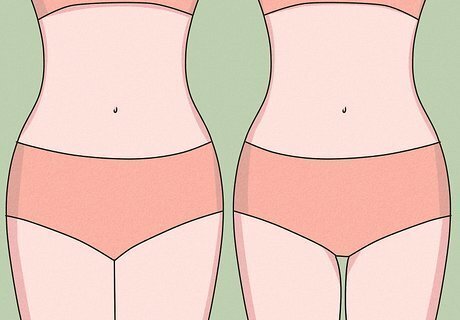
Understand that a thigh gap isn’t physically possible for most people. While you might see supermodels with a wide thigh gap, their type of build isn’t the norm. In fact, a lot of photos of models and celebrities are digitally altered with unrealistic proportions. It's not a given that the if you get lean, you'll get a thigh gap; on the contrary, for tons of people, achieving a thigh gap just isn't possible. Genetics and bone structure play the biggest role when it comes to gaining a thigh gap. Women who have hips that are set very close together are less likely to have a large gap between their thighs. If you have wider set hips, a thigh gap is easier to achieve with the right nutrition and exercise regimen.
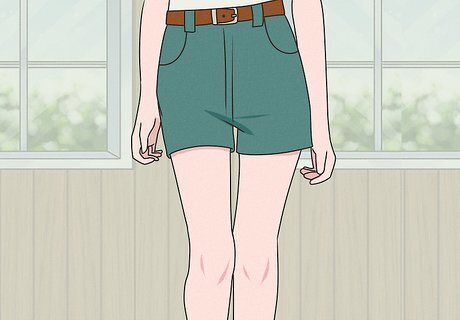
Set realistic expectations. Dieting and exercise will not give you a thigh gap overnight—it is a long-term lifestyle change, not a quick fix. Physical results could take as long as three to four weeks to start showing. Even then, some girls' genetics keep them from achieving a thigh gap, no matter how skinny they are. Whatever the case, it is not healthy to achieve a thigh gap by skipping meals or by exerting yourself to exhaustion. Stay motivated by noticing the ways in which a healthy diet makes you feel better, instead of simply looking better. You might have more energy, or notice that your clothes fit in a more flattering way. It may not be what you wanted, but learning to be happy with who you are is a skill you will need to develop whoever you are.
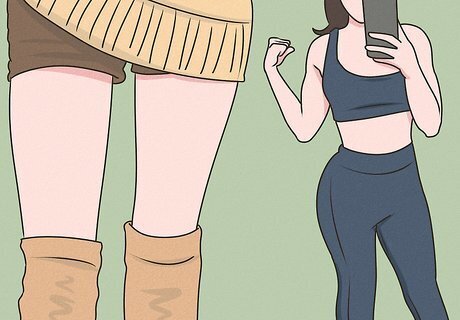
Don't let a thigh gap become your obsession. Getting a thigh gap has become the Holy Grail for some people. They believe they need it or feel inadequate if they don't have it. In serious cases, people focus on it so much that they begin to lose perspective about other important things in life, like health or maintaining social relationships. A troubling number of teens and young girls are treating a thigh gap in an unhealthy way, fasting and possibly developing eating disorders. Don't let the prospect of a thigh gap make or break you. Your thighs do not say anything about you. Do not let anyone tell you what to do. If you feel very negatively about one physical feature, you may have body dysmorphic disorder, which can cause you to be extremely critical of your appearance. If you think you have this condition, seek professional help instead of working on getting a thigh gap. Instead of telling yourself, “I’m not pretty or attractive without a thigh gap,” positively reframe your comment and say something like, “I am so grateful that my legs help me walk, jog, and dance. They’re so strong and beautiful!”

Ask for help if you think that your quest for a thigh gap is unhealthy. If you are after a thigh gap, but the only way you feel you can get it is by starving your body of the nutrients it needs to stay healthy, please ask for help. Anorexia, bulimia, and other eating disorders are serious to your physical health and mental well-being. Especially during your teen years, not getting enough food can have serious health consequences. Starvation negatively affects brain development, heart function, and even reproductive health. Pay attention to these signs that your eating may be turning into a disorder. Do you feel powerful when you skip meals? Do you lie about how much you eat? Are you deathly afraid of gaining weight? Is your self-worth primarily derived from your body weight? If you've answered "yes" to any of these questions, seek out medical advice so that you can get the help you deserve.
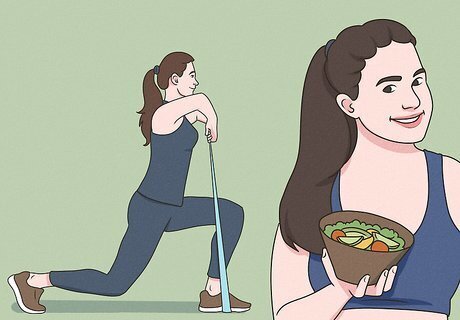
If you still want a thigh gap, stick to a healthy diet and exercise. Try to slowly chip away at any excess weight through a combination of diet and exercise until you hit your doctor-recommended BMI. If you still have not gotten a thigh gap, it may not be possible given your genes and bone structure. And that's okay; you're beautiful exactly as you are. During this process, you became a healthier person, and that's amazing. Even with exercise, it's impossible to target just one area on your body, such as your thighs. This myth is called "spot training". Targeted training, such as in your thigh area, does work, because you take excess weight and turn it into muscle; you'll also be losing fat in other areas as well. You cannot, however, burn fat from a particular area on your body just by working it out.
Dieting the Healthy Way
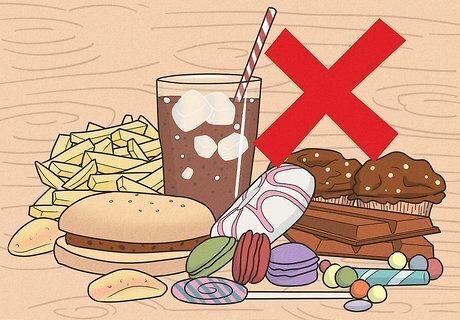
Remove junk food. Instead of restricting your intake, try focusing on eating healthy items that fuel your body (rather than satisfying your sweet tooth). Consider cleaning more of these items out of your diet: Trans fats: These sneaky fats contribute to heart disease and high cholesterol, and are abundant in fast food, processed snack foods (such as potato chips), fried food, shortening , and margarine. If you are not sure if what you're eating has trans fats, check out the nutrition facts. Sugar: Processed sugar packs many calories without offering much nutritional benefit. Avoid artificial sweeteners like sucralose, aspartame or saccharine in your beverages—recent studies have shown possible dangerous side effects of these products; for example, some artificial sweeteners found in diet drinks can increase your risk of a heart attack. Instead, try substituting unsweetened applesauce for sugar in recipes.
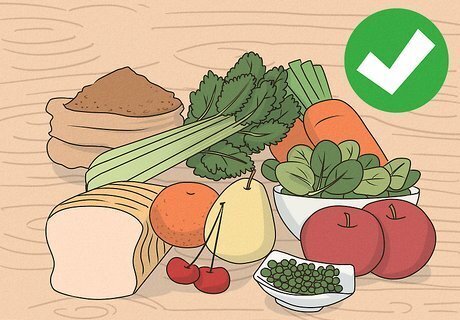
Fill up on fiber. Not only is fiber good for you, it also takes a while to digest and fills up more space in your stomach, so you'll feel less hungry. Try these sources: Fruits and vegetables: Common choices include celery, apples, spinach, cabbage, berries, carrots, pears and oranges (and many others!). Whole grains: Reach for brown grains instead of white ones, like whole-wheat bread, brown rice, wheat tortillas, and wheat pasta. Nuts and beans: Try black beans, almonds, pistachios, pecans and lentils.
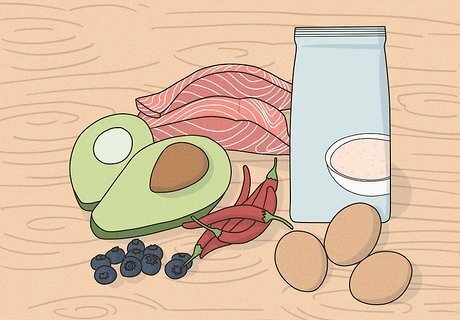
Include some superfoods into your diet. “Superfoods” are foods that contain very low calorie counts and a high fiber content. Some say they you burn more calories digesting superfoods than the foods themselves contain. For example, you’ll burn 72 calories digesting celery, while a serving of celery is only 53 calories. The jury is still out regarding the effectiveness of superfoods regarding weight loss, but many of superfoods are part of a healthy diet, anyway, so you don't have much to lose by choosing them over other higher calorie alternatives. Superfoods that might be worth adding to your diet include: Apples, goji berries, blueberries, and pomegranates Eggs, lentils, almond butter, salmon, and sardines Oats, buckwheat pasta, and quinoa Kale, chiles, tarragon, and avocado Low-fat plain yogurt, and parmesan cheese Olive oil
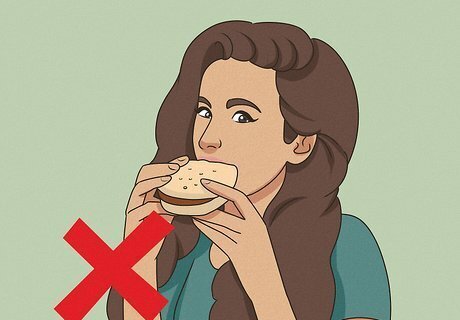
Avoid overeating. If you're eating a healthy diet, but still feel like you're not quite where you'd like to be, review what you're consuming every day. Even small restrictions, like eating 200 fewer calories per day, can lead to safe, gradual weight loss. Keep a food diary. You can write it down the old-fashioned way and look up calories online, or use an app like MyFitnessPal or Spark People.. Whatever you choose, try to be consistent. Figure out your “basal metabolic rate” (BMR). This will tell you how many calories per day you burn simply by existing and allows you to calculate your daily calorie burn rate much more accurately. It is unhealthy to eat below your BMR, but you can try eating 1.2 times as many calories as your BMR. Try cutting your calories intake by about 200 to 300 calories. Make sure to count accurately, as overlooking how much you're eating is the main failing point of most diets. 3500 calories is equal to 1 pound, so by cutting out 300, you should drop 1 pound every 11 days. For more help, see How to Calculate How Many Calories You Need to Eat to Lose Weight. Move past mistakes. If you give in to temptation, don't be discouraged! Everyone slips up once in a while. Simply resolve to get back to your healthy diet.
Toning Your Thighs
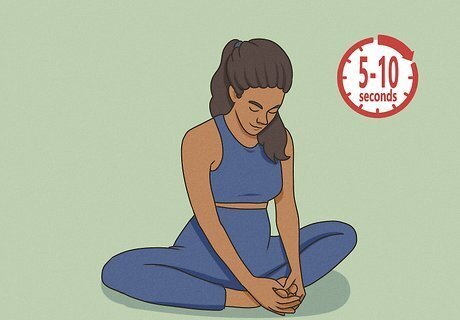
Try butterfly stretches. Sit down on the floor with your back straight and upright. Bend your knees outward and put the soles of your feet together. Pull up your feet to your pelvis—without straining yourself—and lower your thighs so they’re parallel to the ground. Hold for 5-10 seconds. You might need to hold your feet to do this stretch. That’s OK! Instead of vigorously flapping your knees up and down, be gentle. Aim to keep your movements slow and precise. Do a butterfly stretch before you start a circuit of thigh workouts—it’ll help loosen them up and prevent muscle tears.
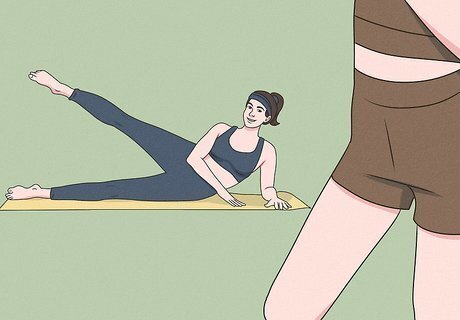
Do “open and close” leg lifts with bent knees. Place a yoga mat on the floor and lay down on it. Bend your legs at the knees so they’re at a 90-degree angle. Spread your knees out as far as possible. Hold for 2 seconds. Return to your starting position. Perform 15-20 repetitions. Keep your movements slow and controlled to fully work out your inner thighs.
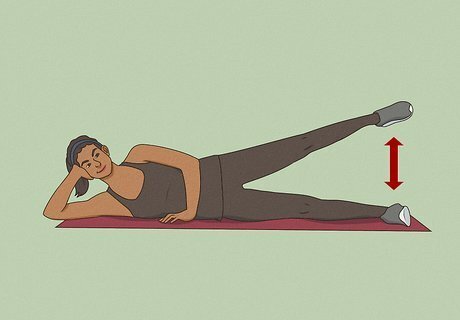
Do Pilates leg lifts. Lie down on your left side and rest your head on your left hand. Bend your right knee and lift it over your left leg. Rest your right shin on the floor. Keep your left leg straight and breathe out. Lift your right leg a few inches. Inhale as you lower it. Do 3 sets of 10 repetitions. Switch to lying down on your right side and repeat for your left leg. Try to keep your torso straight and still as you lift your legs. Move slowly to effectively work out your thighs. If you have a back injury, consult your doctor before trying this exercise.
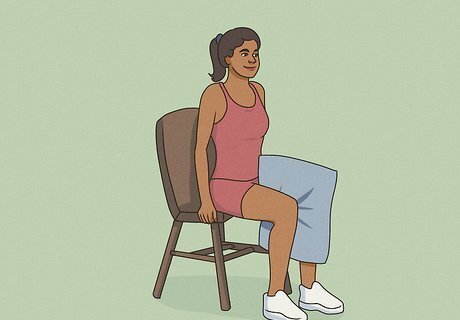
Do a sitting press. Sit up straight in your chair. Keep your back straight and your core tight. Place a towel, pillow, or other small object between your knees. Use your knees to squeeze it as tightly as you can. Hold for 3-5 seconds. Perform 20 repetitions.

Do a bridge press. Lie down on your back. Keep your knees bent and your feet flat on the ground—make sure they’re hip-width apart. Put a pillow, towel, or other soft object between your knees. Lift your pelvis and squeeze the object between your knees as tightly as you can. Perform 20 repetitions before lowering yourself back to the ground.
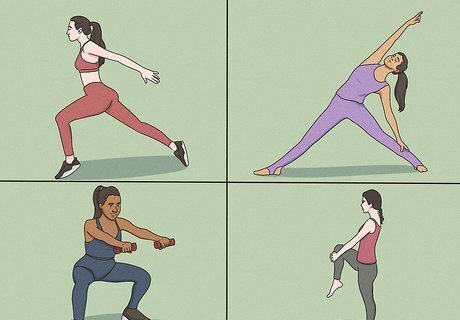
Get aerobic exercise. Aim to get 30 minutes of moderate to intense aerobic exercise at least 3 days a week. Not only will these exercises keep you healthy and help you slim down, they will also tone up your legs in the process. Running, walking briskly, climbing stairs, biking, swimming, and dancing can all help you slim down your legs. Find an exercise that you enjoy and stick with it. If you enjoy your workout, you will be more likely to do it regularly. Try doing interval training where you do a short period of strenuous exercise, such as sprints, before resting for a similar amount of time.
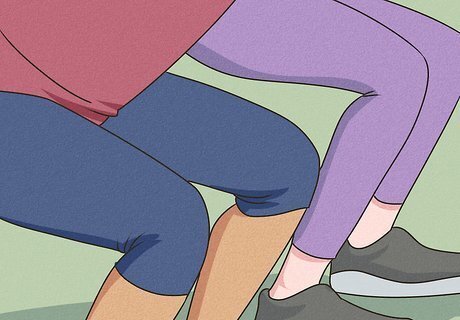
Avoid exercises that bulk up your legs. Keep in mind that squats, lunges, leg curls, and calf raises are great for building muscle and toning up, but they’re not ideal for slimming your legs or achieving a thigh gap. While you don’t have to avoid these exercises altogether, do them in moderation. Focus more on cardio exercises that work your entire body.
Making Thighs Look Slimmer with Cosmetic Tricks
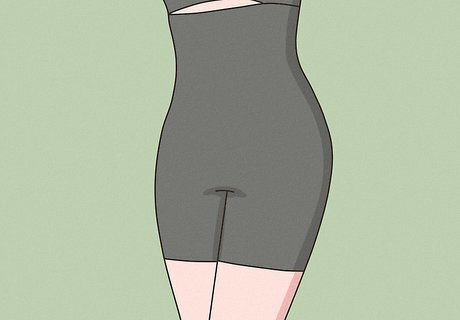
Slip into some shapewear. If you need a thigh gap by tonight for a swanky party or a hot date, your best option is to try on some thigh-slimming shapewear. Go for a good pair of tights with a control top and snug, Spandex-type materials that’ll shape your legs. Make sure to go for shapewear that goes down far enough to cover your entire thigh.
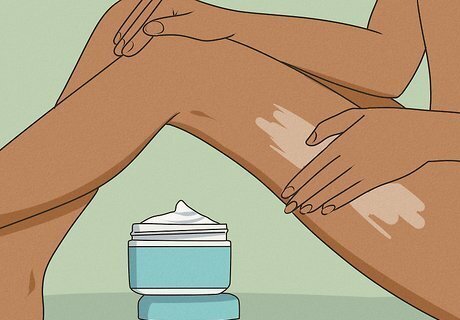
Try an anti-cellulite cream. Purchase a brand that contains caffeine, which stimulates blood flow and may burn off cellulite. Since thigh fat tends to contain cellulite, consistently applying an anti-cellulite cream may improve the appearance of your legs. Massage anti-cellulite cream into your thighs for optimal results.

Consider dry brushing your thighs. Purchase a specialized stiff bristled dry brush online or in a health and beauty section at a store. Brush your thighs in upward strokes—target all areas of your legs that you’d like to tone. Dry brushing helps exfoliate any dead skin and can improve circulation while tightening your skin.
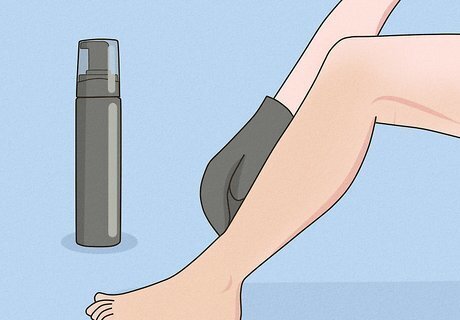
Use self-tanner to create the illusion of toned legs. While self-tanner won’t magically give you a thigh gap, it’s a great option when you want to show off your legs. It’ll definitely reduce the appearance of cellulite. Spray your self-tanner or bronzer from the top of your hips to your ankles. After you’ve evenly coated your legs with your self-tanner, you’ll look phenomenal in a swimsuit or mini-skirt. This is just a fun optical illusion—remember to love and embrace your body no matter what!
Recreating the Thigh Gap Look in Pictures
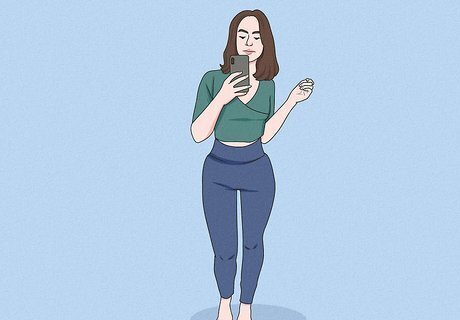
Know that you can look like you have a thigh gap with the right pose. If you want an elegant picture where you appear to have a thigh gap, you don't have to starve yourself and put your body through agony. By "faking" a thigh gap with some clever poses, you could get the look you are after with a whole lot less work. Check out some of our tried and true tricks below!
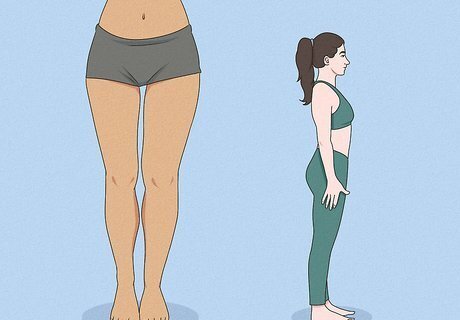
Stand up tall and keep your legs straight. For a subtle but effective pose, maintain good posture and keep your feet about 1 in (2.5 cm) apart. You’ll create some separation between your legs that will make it look like you have a thigh gap.
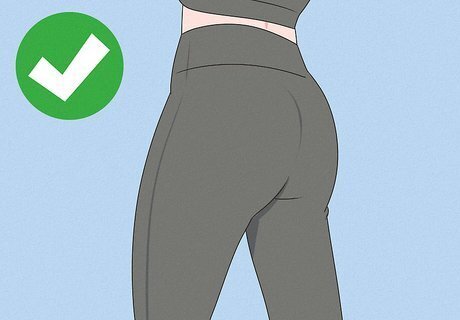
Stick your butt out a little bit. Step forward so your left foot is in front of your right foot. Keep your right leg straight. Arch your back ever so slightly (about .5 in (1.3 cm)) and bend at your left knee to create some space between your inner thighs.
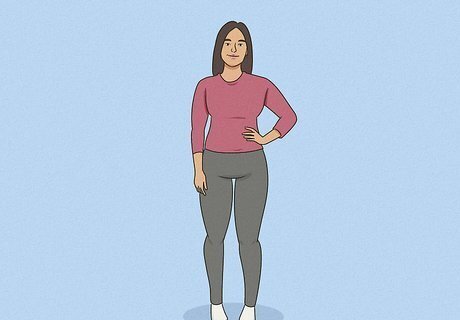
Bend both knees and keep your heels apart. Stand so your toes touch and your heels are pointed in opposite directions. Just spread your heels about 1 in (2.5 cm) outward so your pose looks totally natural.
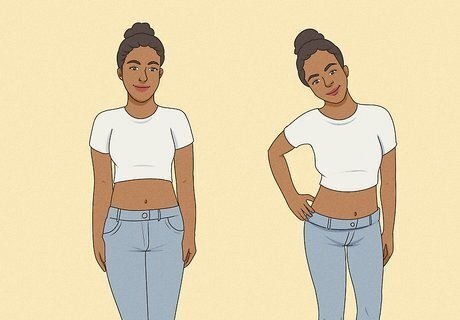
Take your picture at an angle. Keep your camera faced at a downward angle, which is ideal when it comes to creating the illusion of a thigh gap. Choose one of your favorite poses listed above for the best results. If you already naturally have a thigh gap, a downward angle will enhance the appearance of it.
Understanding Hormonal Fixes

Wait out puberty. The surest way to a thigh gap, regardless of weight, is widened hips. If you're not quite through puberty, it's possible that your pelvis simply isn't wide enough yet. Most girls finish developing around the age of 16 or 17, but puberty can continue into the later teens in some cases. . Try to be patient! Don't resort to starving. Puberty involves much growth and change, and you need plenty of nutrients and calories to pull it off. If you deprive yourself, you will stunt the development of your figure. Accept that puberty takes years, not months. You might have a sudden growth spurt over a summer, but the physical transition from childhood to adulthood takes years. Try not to be discouraged if your development is taking longer than other girls you know.
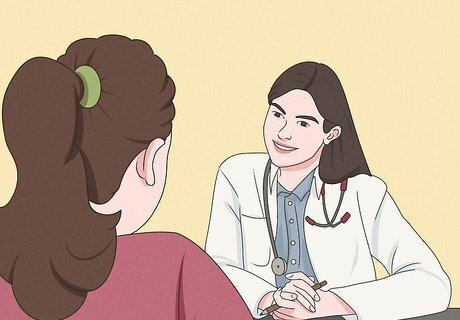
Know when to see a doctor. If you are 15 and have not menstruated yet, consider seeing a gynecologist. You might have another health condition that's delaying puberty. If you suspect that your hormones are seriously out of balance, make an appointment with a gynecologist or reproductive endocrinologist. A simple blood test can tell you a lot about what’s going on with your hormones, and your doctor can prescribe the appropriate medications to help support your development.



















Comments
0 comment